Page 33 of 720
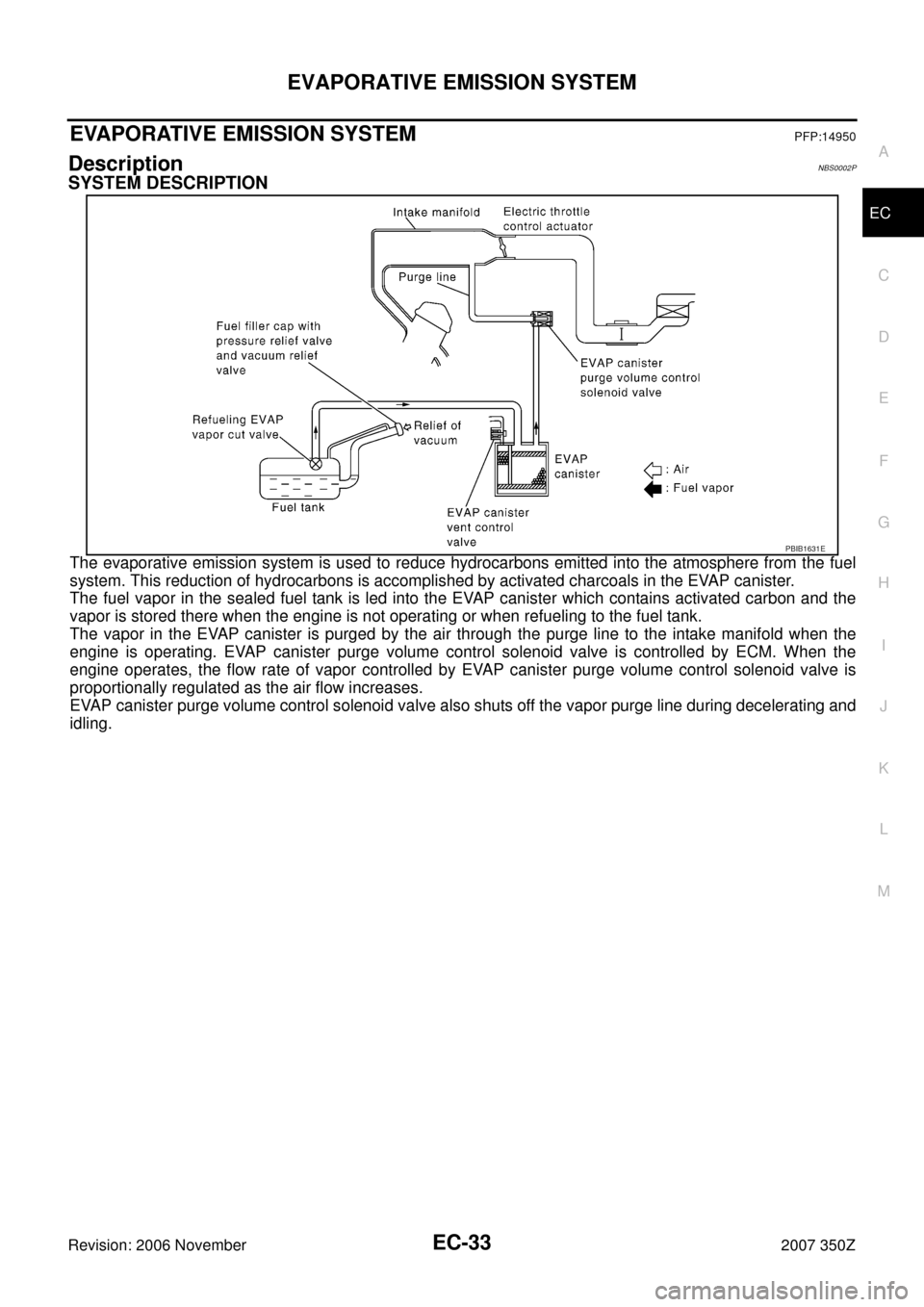
EVAPORATIVE EMISSION SYSTEM
EC-33
C
D
E
F
G
H
I
J
K
L
MA
EC
Revision: 2006 November2007 350Z
EVAPORATIVE EMISSION SYSTEMPFP:14950
DescriptionNBS0002P
SYSTEM DESCRIPTION
The evaporative emission system is used to reduce hydrocarbons emitted into the atmosphere from the fuel
system. This reduction of hydrocarbons is accomplished by activated charcoals in the EVAP canister.
The fuel vapor in the sealed fuel tank is led into the EVAP canister which contains activated carbon and the
vapor is stored there when the engine is not operating or when refueling to the fuel tank.
The vapor in the EVAP canister is purged by the air through the purge line to the intake manifold when the
engine is operating. EVAP canister purge volume control solenoid valve is controlled by ECM. When the
engine operates, the flow rate of vapor controlled by EVAP canister purge volume control solenoid valve is
proportionally regulated as the air flow increases.
EVAP canister purge volume control solenoid valve also shuts off the vapor purge line during decelerating and
idling.
PBIB1631E
Page 36 of 720
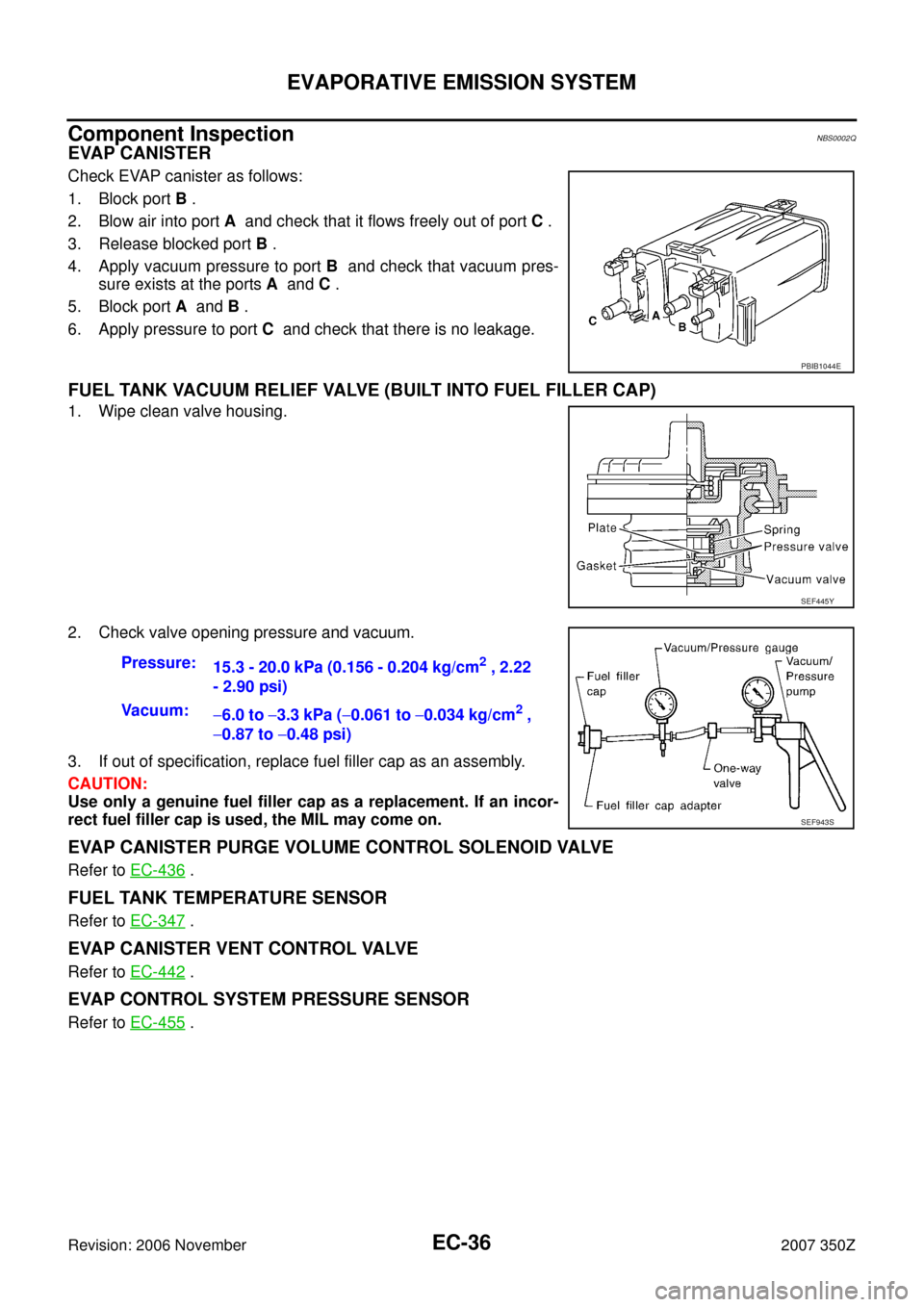
EC-36
EVAPORATIVE EMISSION SYSTEM
Revision: 2006 November2007 350Z
Component InspectionNBS0002Q
EVAP CANISTER
Check EVAP canister as follows:
1. Block port B .
2. Blow air into port A and check that it flows freely out of port C .
3. Release blocked port B .
4. Apply vacuum pressure to port B and check that vacuum pres-
sure exists at the ports A and C .
5. Block port A and B .
6. Apply pressure to port C and check that there is no leakage.
FUEL TANK VACUUM RELIEF VALVE (BUILT INTO FUEL FILLER CAP)
1. Wipe clean valve housing.
2. Check valve opening pressure and vacuum.
3. If out of specification, replace fuel filler cap as an assembly.
CAUTION:
Use only a genuine fuel filler cap as a replacement. If an incor-
rect fuel filler cap is used, the MIL may come on.
EVAP CANISTER PURGE VOLUME CONTROL SOLENOID VALVE
Refer to EC-436 .
FUEL TANK TEMPERATURE SENSOR
Refer to EC-347 .
EVAP CANISTER VENT CONTROL VALVE
Refer to EC-442 .
EVAP CONTROL SYSTEM PRESSURE SENSOR
Refer to EC-455 .
PBIB1044E
SEF445Y
Pressure:
15.3 - 20.0 kPa (0.156 - 0.204 kg/cm2 , 2.22
- 2.90 psi)
Va c u u m :
−6.0 to −3.3 kPa (−0.061 to −0.034 kg/cm
2 ,
−0.87 to −0.48 psi)
SEF943S
Page 37 of 720
EVAPORATIVE EMISSION SYSTEM
EC-37
C
D
E
F
G
H
I
J
K
L
MA
EC
Revision: 2006 November2007 350Z
EVAP SERVICE PORT
Positive pressure is delivered to the EVAP system through the EVAP
service port. If fuel vapor leakage in the EVAP system occurs, use a
leak detector to locate the leak.
Removal and InstallationNBS0002R
EVAP CANISTER
Tighten EVAP canister as shown in the figure.
EVAP CANISTER VENT CONTROL VALVE
1. Turn EVAP canister vent control valve counterclockwise.
2. Remove the EVAP canister vent control valve.
Always replace O-ring with a new one.
How to Detect Fuel Vapor LeakageNBS0002S
CAUTION:
�Never use compressed air or a high pressure pump.
�Do not exceed 4.12 kPa (0.042 kg/cm2 , 0.6 psi) of pressure in EVAP system.
NOTE:
�Do not start engine.
�Improper installation of EVAP service port adapter to the EVAP service port may cause a leak.
SEF462UA
PBIB1029E
PBIB1030E
Page 39 of 720

ON BOARD REFUELING VAPOR RECOVERY (ORVR)
EC-39
C
D
E
F
G
H
I
J
K
L
MA
EC
Revision: 2006 November2007 350Z
ON BOARD REFUELING VAPOR RECOVERY (ORVR)PFP:00032
System DescriptionNBS0002T
From the beginning of refueling, the air and vapor inside the fuel tank go through refueling EVAP vapor cut
valve and EVAP/ORVR line to the EVAP canister. The vapor is absorbed by the EVAP canister and the air is
released to the atmosphere.
When the refueling has reached the full level of the fuel tank, the refueling EVAP vapor cut valve is closed and
refueling is stopped because of auto shut-off. The vapor which was absorbed by the EVAP canister is purged
during driving.
WARNING:
When conducting inspections below, be sure to observe the following:
�Put a “CAUTION: FLAMMABLE” sign in workshop.
�Do not smoke while servicing fuel system. Keep open flames and sparks away from work area.
�Be sure to furnish the workshop with a CO2 fire extinguisher.
CAUTION:
�Before removing fuel line parts, carry out the following procedures:
–Put drained fuel in an explosion-proof container and put lid on securely.
–Release fuel pressure from fuel line. Refer to EC-79, "FUEL PRESSURE RELEASE" .
–Disconnect battery ground cable.
�Always replace O-ring when the fuel gauge retainer is removed.
�Do not kink or twist hose and tube when they are installed.
�Do not tighten hose and clamps excessively to avoid damaging hoses.
�After installation, run engine and check for fuel leaks at connection.
�Do not attempt to top off the fuel tank after the fuel pump nozzle shuts off automatically.
Continued refueling may cause fuel overflow, resulting in fuel spray and possibly a fire.
PBIB1068E
Page 40 of 720
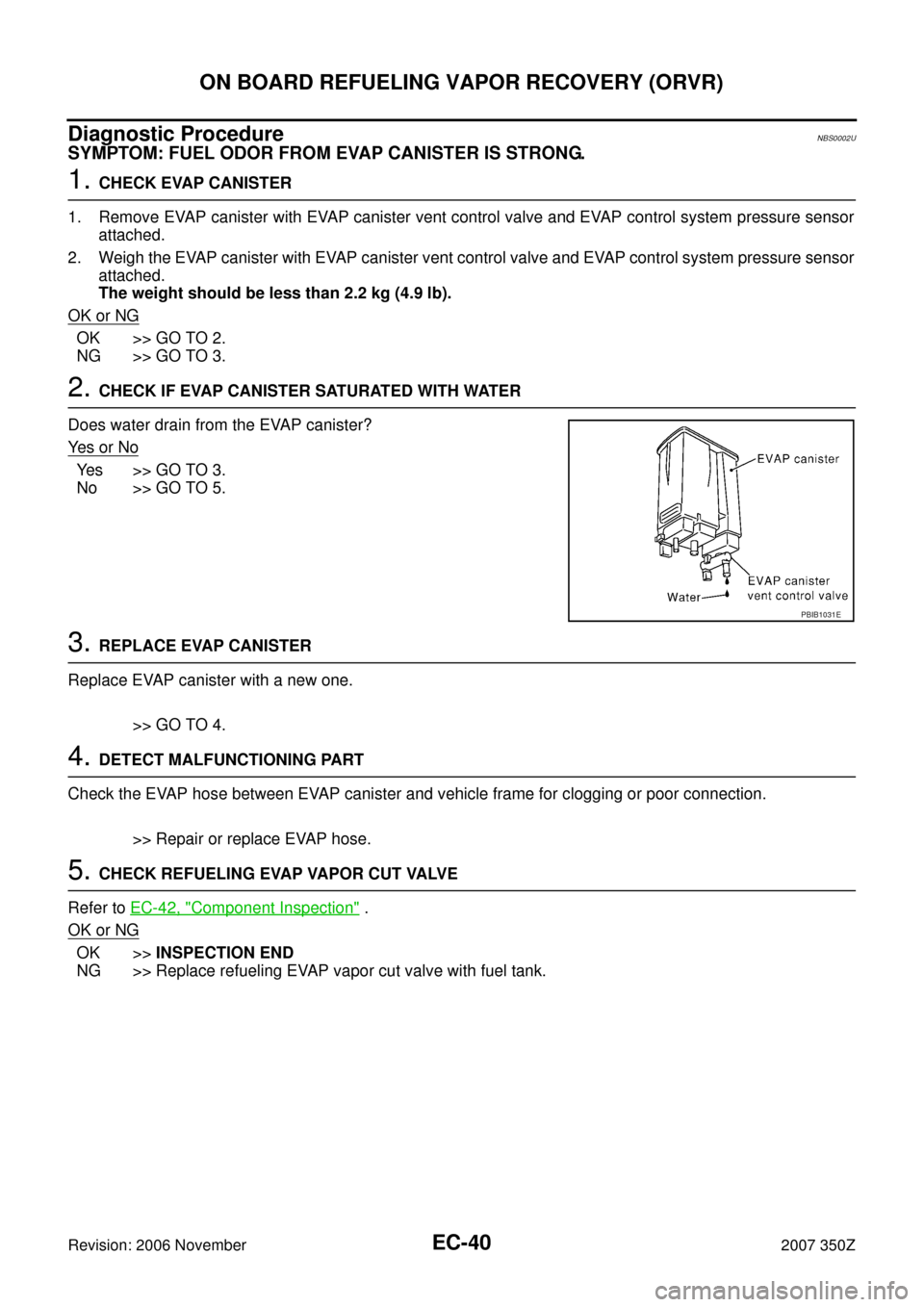
EC-40
ON BOARD REFUELING VAPOR RECOVERY (ORVR)
Revision: 2006 November2007 350Z
Diagnostic ProcedureNBS0002U
SYMPTOM: FUEL ODOR FROM EVAP CANISTER IS STRONG.
1. CHECK EVAP CANISTER
1. Remove EVAP canister with EVAP canister vent control valve and EVAP control system pressure sensor
attached.
2. Weigh the EVAP canister with EVAP canister vent control valve and EVAP control system pressure sensor
attached.
The weight should be less than 2.2 kg (4.9 lb).
OK or NG
OK >> GO TO 2.
NG >> GO TO 3.
2. CHECK IF EVAP CANISTER SATURATED WITH WATER
Does water drain from the EVAP canister?
Ye s o r N o
Yes >> GO TO 3.
No >> GO TO 5.
3. REPLACE EVAP CANISTER
Replace EVAP canister with a new one.
>> GO TO 4.
4. DETECT MALFUNCTIONING PART
Check the EVAP hose between EVAP canister and vehicle frame for clogging or poor connection.
>> Repair or replace EVAP hose.
5. CHECK REFUELING EVAP VAPOR CUT VALVE
Refer to EC-42, "
Component Inspection" .
OK or NG
OK >>INSPECTION END
NG >> Replace refueling EVAP vapor cut valve with fuel tank.
PBIB1031E
Page 41 of 720
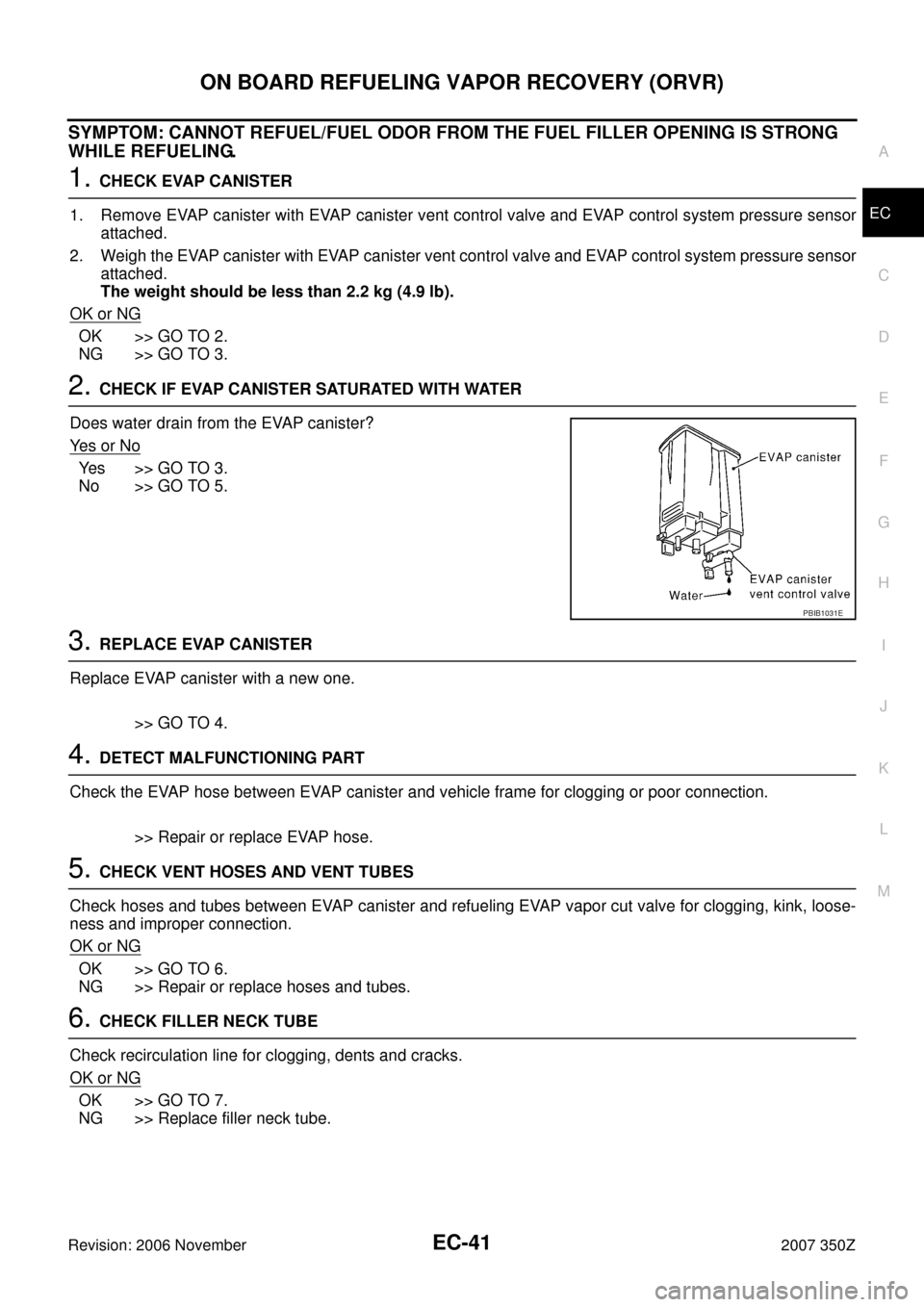
ON BOARD REFUELING VAPOR RECOVERY (ORVR)
EC-41
C
D
E
F
G
H
I
J
K
L
MA
EC
Revision: 2006 November2007 350Z
SYMPTOM: CANNOT REFUEL/FUEL ODOR FROM THE FUEL FILLER OPENING IS STRONG
WHILE REFUELING.
1. CHECK EVAP CANISTER
1. Remove EVAP canister with EVAP canister vent control valve and EVAP control system pressure sensor
attached.
2. Weigh the EVAP canister with EVAP canister vent control valve and EVAP control system pressure sensor
attached.
The weight should be less than 2.2 kg (4.9 lb).
OK or NG
OK >> GO TO 2.
NG >> GO TO 3.
2. CHECK IF EVAP CANISTER SATURATED WITH WATER
Does water drain from the EVAP canister?
Ye s o r N o
Ye s > > G O T O 3 .
No >> GO TO 5.
3. REPLACE EVAP CANISTER
Replace EVAP canister with a new one.
>> GO TO 4.
4. DETECT MALFUNCTIONING PART
Check the EVAP hose between EVAP canister and vehicle frame for clogging or poor connection.
>> Repair or replace EVAP hose.
5. CHECK VENT HOSES AND VENT TUBES
Check hoses and tubes between EVAP canister and refueling EVAP vapor cut valve for clogging, kink, loose-
ness and improper connection.
OK or NG
OK >> GO TO 6.
NG >> Repair or replace hoses and tubes.
6. CHECK FILLER NECK TUBE
Check recirculation line for clogging, dents and cracks.
OK or NG
OK >> GO TO 7.
NG >> Replace filler neck tube.
PBIB1031E
Page 42 of 720
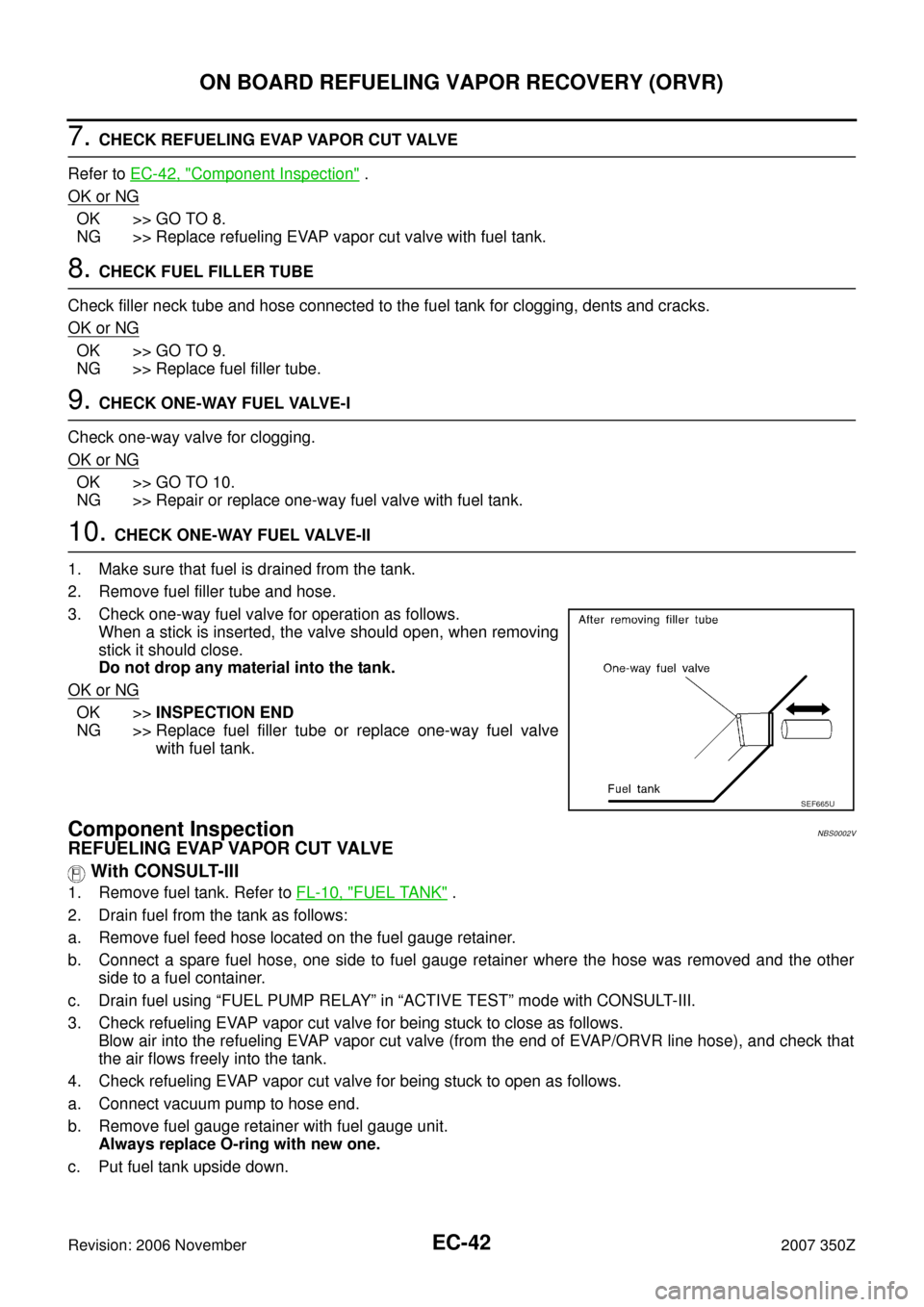
EC-42
ON BOARD REFUELING VAPOR RECOVERY (ORVR)
Revision: 2006 November2007 350Z
7. CHECK REFUELING EVAP VAPOR CUT VALVE
Refer to EC-42, "
Component Inspection" .
OK or NG
OK >> GO TO 8.
NG >> Replace refueling EVAP vapor cut valve with fuel tank.
8. CHECK FUEL FILLER TUBE
Check filler neck tube and hose connected to the fuel tank for clogging, dents and cracks.
OK or NG
OK >> GO TO 9.
NG >> Replace fuel filler tube.
9. CHECK ONE-WAY FUEL VALVE-I
Check one-way valve for clogging.
OK or NG
OK >> GO TO 10.
NG >> Repair or replace one-way fuel valve with fuel tank.
10. CHECK ONE-WAY FUEL VALVE-II
1. Make sure that fuel is drained from the tank.
2. Remove fuel filler tube and hose.
3. Check one-way fuel valve for operation as follows.
When a stick is inserted, the valve should open, when removing
stick it should close.
Do not drop any material into the tank.
OK or NG
OK >>INSPECTION END
NG >> Replace fuel filler tube or replace one-way fuel valve
with fuel tank.
Component InspectionNBS0002V
REFUELING EVAP VAPOR CUT VALVE
With CONSULT-III
1. Remove fuel tank. Refer to FL-10, "FUEL TANK" .
2. Drain fuel from the tank as follows:
a. Remove fuel feed hose located on the fuel gauge retainer.
b. Connect a spare fuel hose, one side to fuel gauge retainer where the hose was removed and the other
side to a fuel container.
c. Drain fuel using “FUEL PUMP RELAY” in “ACTIVE TEST” mode with CONSULT-III.
3. Check refueling EVAP vapor cut valve for being stuck to close as follows.
Blow air into the refueling EVAP vapor cut valve (from the end of EVAP/ORVR line hose), and check that
the air flows freely into the tank.
4. Check refueling EVAP vapor cut valve for being stuck to open as follows.
a. Connect vacuum pump to hose end.
b. Remove fuel gauge retainer with fuel gauge unit.
Always replace O-ring with new one.
c. Put fuel tank upside down.
SEF665U
Page 43 of 720
![NISSAN 350Z 2007 Z33 Engine Control Workshop Manual ON BOARD REFUELING VAPOR RECOVERY (ORVR)
EC-43
C
D
E
F
G
H
I
J
K
L
MA
EC
Revision: 2006 November2007 350Z
d. Apply vacuum pressure to hose end [−13.3 kPa (−100 mmHg, −3.94 inHg)] with fuel gauge NISSAN 350Z 2007 Z33 Engine Control Workshop Manual ON BOARD REFUELING VAPOR RECOVERY (ORVR)
EC-43
C
D
E
F
G
H
I
J
K
L
MA
EC
Revision: 2006 November2007 350Z
d. Apply vacuum pressure to hose end [−13.3 kPa (−100 mmHg, −3.94 inHg)] with fuel gauge](/manual-img/5/762/w960_762-42.png)
ON BOARD REFUELING VAPOR RECOVERY (ORVR)
EC-43
C
D
E
F
G
H
I
J
K
L
MA
EC
Revision: 2006 November2007 350Z
d. Apply vacuum pressure to hose end [−13.3 kPa (−100 mmHg, −3.94 inHg)] with fuel gauge retainer
remaining open and check that the pressure is applicable.
Without CONSULT-III
1. Remove fuel tank. Refer to FL-10, "FUEL TANK" .
2. Drain fuel from the tank as follows:
a. Remove fuel gauge retainer.
b. Drain fuel from the tank using a handy pump into a fuel container.
3. Check refueling EVAP vapor cut valve for being stuck to close as follows.
Blow air into the refueling EVAP vapor cut valve (from the end of EVAP/ORVR line hose), and check that
the air flows freely into the tank.
4. Check refueling EVAP vapor cut valve for being stuck to open as follows.
a. Connect vacuum pump to hose end.
b. Remove fuel gauge retainer with fuel gauge unit.
Always replace O-ring with new one.
c. Put fuel tank upside down.
d. Apply vacuum pressure to hose end [−13.3 kPa (−100 mmHg, −3.94 inHg)] with fuel gauge retainer
remaining open and check that the pressure is applicable.
PBIB1035E
PBIB1035E